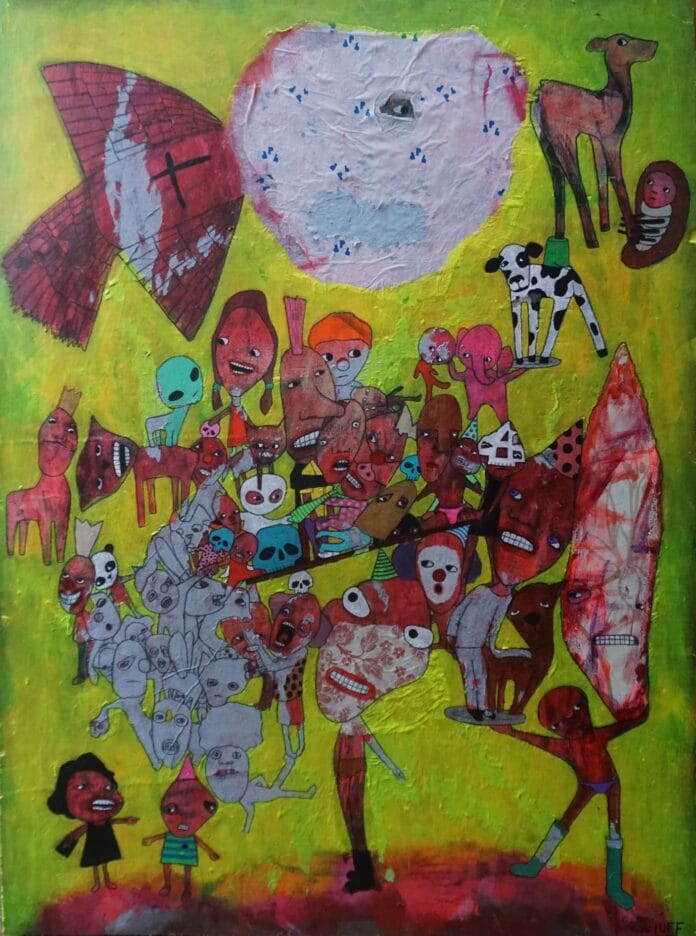In a world increasingly shaped by digital excess and mass production, artist Sam Luff stands as a thoughtful voice pushing back—rooted in nature, emotion, and spontaneity. Describing himself as an “outsider looking inside,” Luff approaches his creative process not from a place of training or tradition, but through personal transformation. His journey into art was not linear—it evolved from rigid formality into a fluid, organic expression of inner and outer worlds.
Today, Luff’s work resists the predetermined. His art isn’t plotted or formulaic; instead, it arises from lived experience, from emotions stirred by the environment, and from the unpredictable nature of being. His preferred medium acrylic offers immediacy, capturing the urgency and presence of the moment. Increasingly, Luff paints on salvaged materials, most often recycled plywood, a choice reflecting both his environmental awareness and philosophical stance against consumerism.
The Shift: From Clean to Raw
He says it was not always this way. His early ideas of art were steeped in traditional ideals: oil on canvas, a brush in hand, and a neatly arranged composition on an easel. His early works were thought-based—structured, clean, and guided by what art was supposed to be. But that conception eventually crumbled.
It wasn’t technique or schooling that led to Luff’s artistic breakthrough, but rather a quiet internal voice—a call to let go. This voice disrupted his need for perfection and control. From that point forward, his work took on a new lifeless construction that was more felt. The change marked a return to essence, to intuition, to things often overlooked in a world of polished surfaces.
Embracing Imperfection
There’s something radical about abandoning control, especially in a culture that rewards precision and polish. But Luff finds power in imperfection. In his view, art is not a mirror but a conversation with feeling—messy, emotive, and tangled. By painting on salvaged surfaces like discarded plywood, he adds another layer of meaning to his pieces. These materials, already weathered by life, offer texture and history. They bring the story of the world into the work.
This move away from clean materials and conventional support is as much a rejection of consumerism as it is an aesthetic choice. Luff’s paintings feel grounded, tactile, and real—echoing the natural world in both medium and message. “Nothing is predetermined,” he emphasizes, and in that uncertainty lies authenticity.
The Power of the Trigger
Luff’s most recent works are emotionally charged, often described as visual manifestations of a singular, intense feeling a trigger moment—that makes everything else feel like paper by comparison. One such painting, created with acrylic and mixed media on recycled plywood, encapsulates this idea.
The surface—once part of something utilitarian, now transformed—bears the marks of its past. The acrylic dances across the board with urgency and grace, layers built in real time, responding to instinct rather than plan. Texture builds. Colors bleed. The artwork becomes a sensory landscape, charged with the energy of that one unforgettable moment.
It’s not about what’s painted, but how it’s felt.
A Conversation With Nature
Nature plays a crucial role in Luff’s worldview and practice—not as a subject to be captured, but as a model for how to exist. The trees, the wind, the cycles of decay and renewal—all are unplanned yet perfectly balanced. His paintings attempt to emulate this rhythm, not in representation, but in process.
Just as leaves fall without intent and rivers flow without maps, Luff’s work emerges. It is not overly labored. It is in the moment. This immediacy gives his pieces a quiet intensity—they feel alive, vibrating with unseen emotion.
Refusing the Expected
In many ways, Luff’s journey is a rebellion against expectation. Against the tidy boxes that define what art should look like or how an artist should work. He finds freedom in dismantling these frameworks, building something more honest in their place.
He does not strive for spectacle or approval. Instead, his focus lies in truth—the kind you can’t always name but can always feel. It’s an honesty that emerges not from concept but from contact—with materials, with memory, with nature, with self.
Conclusion: The Quiet Radical
Sam Luff may call himself an outsider, but his voice is anything but marginal. His work offers an important reminder in a hyper-stimulated world: that feeling matters, that process matters, and that there is profound value in what is spontaneous, imperfect, and raw.
By choosing salvaged wood over store-bought canvas, and instinct over intellectual design, Luff reclaims art as something closer to life itself—unscripted, connected, and quietly radical.


